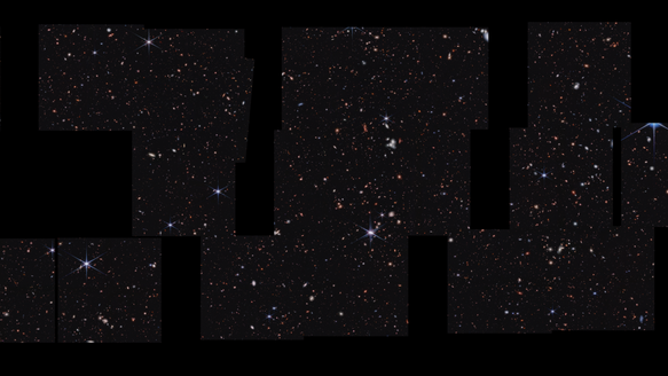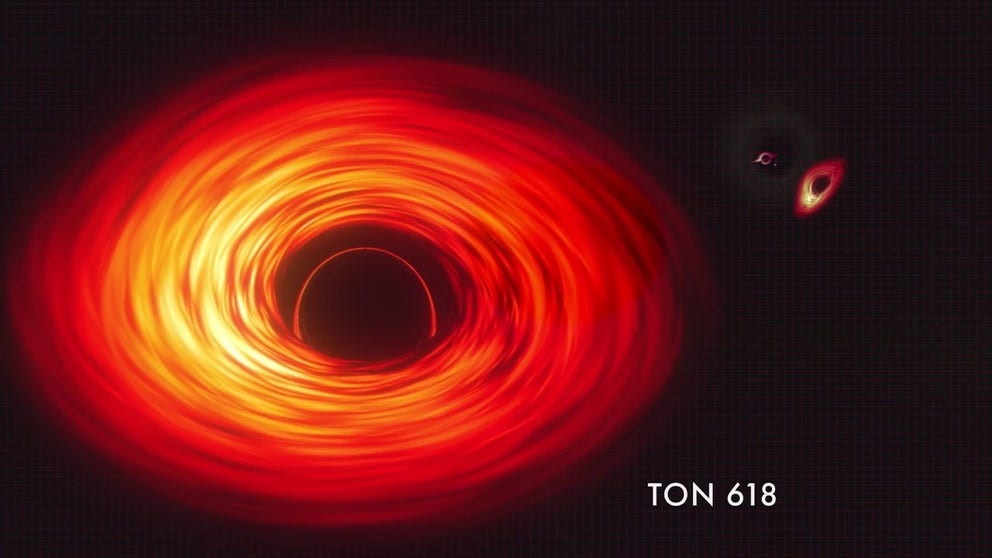James Webb Space Telescope finds most distant supermassive black hole hiding among tapestry of galaxies
According to NASA, what’s interesting about CEERS 1019 and its supermassive black hole is how little the black hole weighs, about 9 million solar masses. Other black holes from the early universe can contain 1 billion solar masses.
How big are supermassive black holes compared to Earth?
All monster black holes are not equal. Watch this video to see how they compare to each other and to our solar system.
Using the James Webb Space Telescope, researchers have discovered the most distant active supermassive black hole ever and by astronomical standards, it's tiny.
Hiding among a tapestry of galaxies, the black hole belongs to the galaxy CEERS 1019, which existed about 570 million years after the Big Bang.
Most galaxies have a supermassive black hole at the center. How they begin forming is one of the many mysteries of black holes. Astronomers do know they grow by feeding off smaller objects or through galaxy mergers.
SUPERMASSIVE BLACK HOLES: JUST HOW BIG ARE THEY?
The discovery was revealed when NASA released images from Webb’s Cosmic Evolution Early Release Science (CEERS) Survey, led by Steven Finkelstein of the University of Texas at Austin.

This image was stitched together from multiple images captured by the James Webb Space Telescope in near-infrared light. To the right of center is a clump of bright white spiral galaxies that seem to be twisting into one another. Threaded throughout the scene are light pink spirals that look like pinwheels twirling in the wind. The bright foreground stars, set off in blue, announce themselves with Webb’s prominent eight-pointed diffraction spikes. (Credits: NASA, ESA, CSA, Steve Finkelstein (UT Austin), Micaela Bagley (UT Austin), Rebecca Larson (UT Austin)
(NASA)
As seen above, detailed images stitched together include near- and mid-infrared images and spectra data. In the same composite image, researchers found two more black holes and 11 galaxies that existed when the universe was 470 to 675 million years old.
Record may be broken in a couple weeks
According to NASA, what’s interesting about CEERS 1019 and its supermassive black hole is how little it weighs. This one is estimated to be about 9 million solar masses. Astronomers use our Sun's mass to measure huge things in the universe, such as black holes. The mass of a black hole is usually called a "solar mass." One solar mass is defined as the mass of our Sun.
CEERS 1019 is considered small and much harder to spot because its mass is much less than other black holes from the early universe, which can contain 1 billion solar masses.
Black holes are a true enigma of the universe with more questions than facts. Webb's powerful instruments have helped astronomers confirm small black holes, which have been thought to exist earlier in the universe.
Even though this black hole discovery is big news, NASA said it likely won’t hold its title very long.
"CEERS 1019 may only hold this record for a few weeks – claims about other, more distant black holes identified by Webb are currently being carefully reviewed by the astronomical community," the space agency said.
